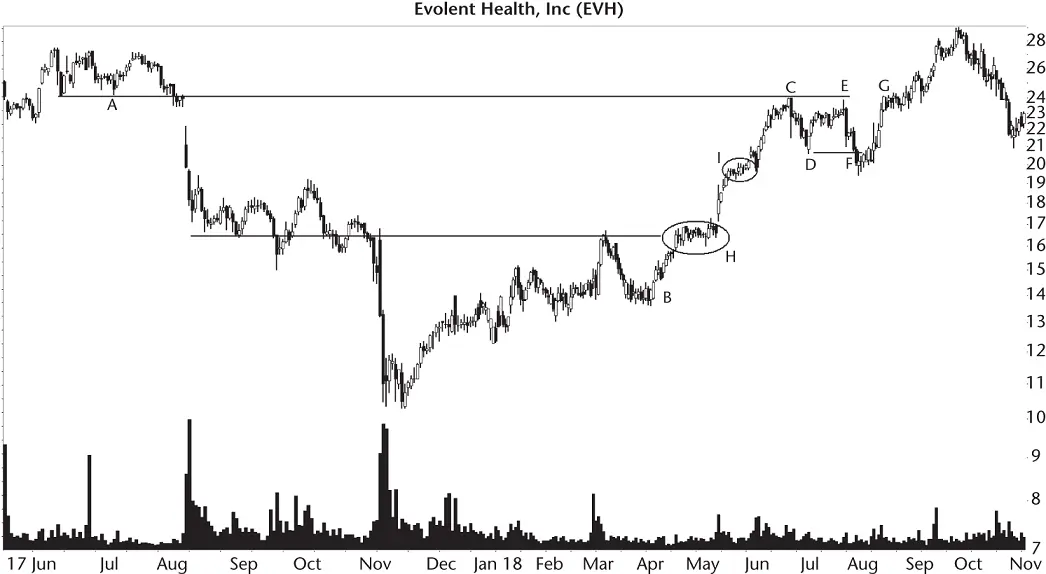Return to launch price.I also computed the percentage of time that price, at the ultimate low, met or dropped below the launch price. The last line in the table shows that it reached the launch price just over half the time in bull markets.
One challenge of using this method is to figure out where the launch price is. Often it's the same as the trend start (see the Glossary). The launch price is the location where price begins rising into the big M in earnest. In the first three figures of this chapter, the launch price is point A. In Figure 6.4, it's point B.
After you determine a measure rule target, convert the potential decline into a percentage of the current price. For example, if the height is $10 and the stock is trading at 50, that's a potential 20% loss (10/50 × 100). Table 6.3says that in bull markets, big Ms fail to see a stock drop more than 20% about two‐thirds (68%) of the time. That suggests a large decline probably won't happen but your trade may be the exception. Visit with Table 6.3and make the check.
Stop location.Use Table 6.7to help determine where a stop loss‐order should be located. If you're planning to short the stock, then do use a stop.
After you locate the stop, determine if the potential loss is big enough that you might need to reconsider the stop location. If you can't find a reasonable loss value (like 8% or less), then abandon the trade. Another big M will come along shortly. I saw the schedule.
Pullback trade.This setup idea should be used only by experienced traders. You can place an order to short the stock a penny below the bottom of the big M and cover at the bottom of the pullback. Table 6.4can help determine your chance of making money using this technique.
In more than two out of every three trades (67% in bull markets, from Table 6.4) a big M will show a pullback within a month of the breakout, often in the first week.
Price drops for an average of 6 days and returns to the breakout price (or near it), in a roundtrip total of 12 days. The drop from the breakout to the low at the bottom of the pullback attempt measures 7% to 10% (for bull and bear markets, respectively). If you short the stock a penny below the breakout and place an order to cover the short 5% to 7% lower than the breakout, you might be able to catch the drop and make a profit.
The median decline is 6% (bull market) to 8% (bear market) in 5 days (for both markets).
Busted trade.Another way to trade a big M is to buy the stock long if the big M busts. After busting a downward breakout, price soars an average of 55% for a single busted pattern. Even if you only capture half of that, it's still a big gain. See Table 6.9for details. The trick is to pick single busted trades, so look for overhead resistance within 10% of the breakout price, which might send the stock scurrying for cover.
Tips.I don't have any trades in big Ms to share with you because I don't like to short stocks. However, I do have some tips I want to pass on from what I've learned studying them in the bush.
Look at Figure 6.4with a big M at CE. Notice the knot of support circled at I. If I was shorting this stock, this knot of support would be my first choice for where the stock will turn.
The knots need not be midway up from the launch price (but they do tend to be about midway). That is, it's about midway up the move from B to C.
What you want to look for is 3 days (or more) of horizontal price movement. Not a loose meandering of price, but a tight sideways move with lots of overlap. H is a good example of what to look for, but it's often shorter than what's shown. I is a good example. The two weeks to the left of B shows a third example of what to look for (not the placement in the BC run, but the type of horizontal move you're looking for). Sometimes it's only 3 or 4 days wide, but it's enough to support price.
The knot of support should be the first one below the confirmation price. In this example, D is the confirmation price of the big M. Notice that price drops to F and finds support at I. As a price target, pick the highest price in the knot. Chapter 1gives a good tutorial on knots, so reread that if you need a refresher.
Here's another scenario. Price moves up like you see from B to C. However, the closest knot of support is below the price of a prior peak (looking back a year or two). That prior peak will act as support, and the stock will likely turn there. In other words, as price drops, it first finds support at the prior peak, and if it were to continue down, it would then find support at a knot along the BC run. The high price of the peak would be my target.
In another scenario, you'll see price confirm the big M and then reverse. Price climbs a few percent (up to 4% or so) above the top of the big M and then reverses. Often a strong move down follows.
It's like traders push up the stock to hit stop‐loss orders placed by the shorts, and once they are out of their positions, they drive price lower, cleaning the table.
What I'm describing is an example of a double busted big M. Those are nasty for shorts unless they time it right. How do we play this scenario? Price closes above the top of the big M, busting the downward breakout and then reverses to head back down. That's the time to short.
Finally, in a number of cases, I saw a large gap open as price climbed up to the big M (during the BC rise). The top of those gaps supported price on the way down, so they make for a good price target.
Table 6.11shows information that I mentioned previously but decided to put in a table for your viewing pleasure.
Table 6.11 Special Features
| Description |
Bull Market |
Bear Market |
| Higher left peak, performance |
16% |
22% |
| Higher right peak, performance |
17% |
22% |
| Even peak, performance |
18% |
19% |
|
|
|
| Median days from launch price to left peak |
27 |
23 |
| Median days from right peak to ultimate low |
49 |
40 |
Higher peak performance.I looked at performance based on which peak of the big M was above the other (or even). In bull markets, a higher right peak suggests better performance. I would have guessed that a lower right peak would suggest a weak situation, but maybe a higher peak means there's farther to drop.
Time to drop.I measured the median time to rise from the launch price to the first peak compared to the drop from the right peak to the ultimate low. The time is about two to one. So you can measure the time from the move up to the first peak, double it, and that will give you an estimate of how long you'll need to remain in the trade to reach the ultimate low. My guess is it won't be that easy, but at least you'll have an estimate.
Justin is an experienced trader, and he's shorted enough stocks to become proficient at it. “I got interested right there.” In Figure 6.4, he pointed to the strong drop the day after peak E and made plans to trade the big M (the twin peaks at C and E).

Figure 6.4Justin shorted this big M and lost money on the trade.
Price started a concerted effort to climb when it broke out of a congestion region at B. Price paused at H and moved sideways for a time when it hit overhead resistance set up by the sideways move from August to November 2017 (shown by a horizontal line connecting circle H).
Читать дальше













